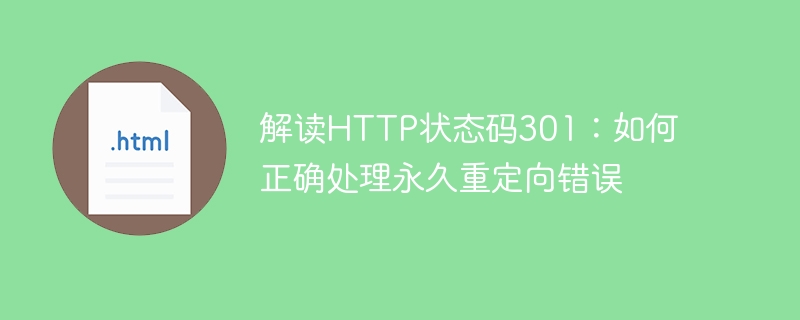
Interpreting HTTP status code 301: How to correctly handle permanent redirect errors
HTTP status codes are a very important part of web applications. They provide the client with information about Information about the processing status of the request. The 301 status code is a special status code that indicates that the requested resource has been permanently moved to a new location. In this article, we will interpret the 301 status code and discuss how to properly handle permanent redirect errors.
1. Understanding the 301 status code
When the server receives a request from the client, if the requested resource has been permanently moved to a new location, the server will return the 301 status code and Provide the new resource location in the response header. After receiving the 301 status code, the client will automatically send a request to the new location and redirect the user to the new resource.
2. The role of 301 status code
- Keep the search engine index updated: When changing the website structure or resource location, by returning the 301 status code, you can tell the search engine to update the old The resource location is updated to the new location. This helps keep search engine indexes correct and up to date.
- User directed to new resource location: By using the 301 status code, you can ensure that users are automatically redirected to the new location when accessing old resources, providing a better user experience.
3. How to correctly handle the 301 status code
- Provide correct URL redirection: Make sure to provide the correct new resource location in the response header of the 301 status code. To do this, you need to use absolute paths rather than relative paths to ensure that the client can accurately find the new location.
- Update internal links within the website: Within the website, if there are links pointing to resources that are permanently redirected, these links need to be updated to point to the new resource location. This helps maintain the correctness of the website's internal link structure and reduces the occurrence of invalid links.
- Notify search engines: When the location of a large number of resources in the website changes, you can notify the search engine to update the index by publishing a site map or submitting an updated request to the search engine. This ensures that search engines update the location of the resource in a timely manner and avoids 404 errors.
- Provide friendly error pages: When users access resources that are permanently redirected, some errors may occur. To provide a better user experience, you can provide friendly error pages for these error conditions, prompting the user that the resource has been permanently transferred, and providing the correct location of the new resource.
- Monitor redirect errors: Regularly monitor the redirect errors of the website to discover and solve problems in a timely manner. You can use tools or services to detect and report redirect errors to ensure that your website's redirect strategy is effective and correct.
Summary:
Properly handling permanent redirect errors is critical to the user experience and search engine optimization of your website. By returning the correct 301 status code and taking corresponding measures, such as providing correct URL redirection, updating website internal links, notifying search engines, etc., you can ensure the correct redirection of resources, provide a good user experience, and keep search engines at the same time. The index is correct and up to date. Most importantly, monitor and resolve redirect errors regularly to ensure proper functioning and optimization of your website.
The above is the detailed content of Interpreting HTTP Status Code 301: How to Correctly Handle Permanent Redirect Errors. For more information, please follow other related articles on the PHP Chinese website!






